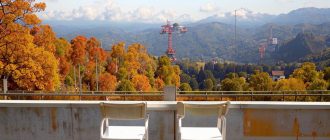Spain right now: how to get there and what to see? Traveler’s Notes

Vladimir Vinogradov tells how to get to this country from Russia and what cultural program awaits tourists.

President of Pro-Vision, author of the Vinogradov.story community
“In the last couple of years, traveling in Europe is talked about more in the context of pleasant nostalgia than plans for the future. And yet some European countries are still open to Russians and offer a rich and very interesting travel program. One of them is Spain. How to get to the Pyrenees now and where you should definitely visit while traveling around the peninsula, I will tell you below”.
Road to Spain
Today there are no direct flights between Russian and Spanish cities. You will have to fly with at least one connection – in Istanbul or Cairo. More exotic options – stopover in Casablanca or Baku. I chose Baku and did not regret it.
If you plan a layover for more than 12 hours, you can safely go out into the city and have time to visit a couple of interesting locations. The main thing is that both segments of the flight were on the wings of one airline. In this case, the risk of not getting on your flight is minimal: in Baku, for example, our late Moscow flight was calmly waited for, combined with passengers from other regions and safely sent to Barcelona.
What to see?
Barcelona
The capital of Catalonia was lucky to be the place where Gaudi’s architectural genius was revealed. Once in Barcelona, you won’t pass by Sagrada Familia, Palace and Park Güell, but I recommend leaving time for other, though not so popular, but no less interesting locations. This is the Gothic Quarter, where it is best to walk around without a map, getting lost in the chaotic medieval development of alleys and dead ends.
And the picturesque Citadel Park – the kingdom of nature within the city, where you can meet the legendary hand green parrots. And the El Born Art Quarter, perhaps the largest open-air street art gallery in the city. It’s best to come here in the early morning: this is the only way to view the street art without elbowing each other and enjoying the natural sun “illumination” of the works.
Granada
Granada is a city with a complicated past and an amazing present, where many cultures and religions coexist as neighbors. It remembers well how the era of Moorish rule, Reconquista and Renaissance replaced each other. And carefully preserves in the city limits the most valuable treasures of each of them. The “Eighth Wonder of the World”, the Alhambra architectural and park ensemble, recalls the Arab rule with its skillful stone lace, arcaded galleries, aquamarine finishes and innovative for the era irrigation systems.
Directly across the street, the Moorish neighborhood of Albaycin descends to the Darro River. And on the hilly outskirts flows a completely different life – gypsy life, bright and original, but forcibly hidden under the vaults of caves. By the way, it was in the “gypsy caves” of Granada, “gitanos”, if you believe the legends, the first sound of flamenco. And this is only one of a thousand reasons to look into the heart of Andalusia.
Bilbao
Once an unassuming industrial and port city, today Bilbao is an illustrious center of the Basque Country and one of the world’s architectural centers. It is known to contemporaries primarily due to the “Guggenheim effect”: when a branch of the famous museum was opened in Bilbao in 1997, a “cultural miracle” occurred – thousands of tourists were drawn to the north of Spain. In response to this, the city’s infrastructure was also pulled up, which started a global urban trend of creating cultural dominants on the conventional periphery. But the success of Bilbao has not yet been repeated.

Guggenheim Museum in Bilbao
Madrid
Madrid may seem impersonal and metropolitan against the background of authentic Barcelona, Granada or Seville: after all, its administrative status gives the city a somewhat “formal” connotation. Nevertheless, there is a lot to see in Madrid, especially for those who appreciate fine art.
In the “Golden Triangle” of the Spanish capital there are three treasuries of world painting and sculpture – the Prado Museum, the Queen Sofia Art Center and the Thyssen-Barnemisza Museum. Dividing expositions by chronology and directions, they cover almost the entire history of world art! In between, it is worth taking time out to visit the Royal Palace and the green Buen Retiro Park.

Madrid







